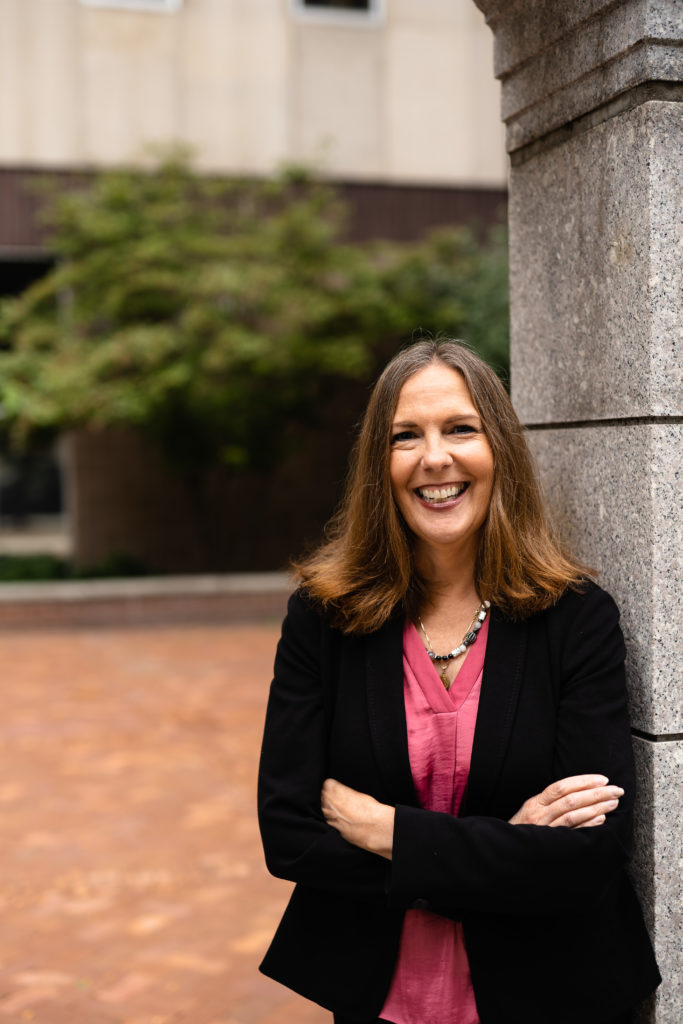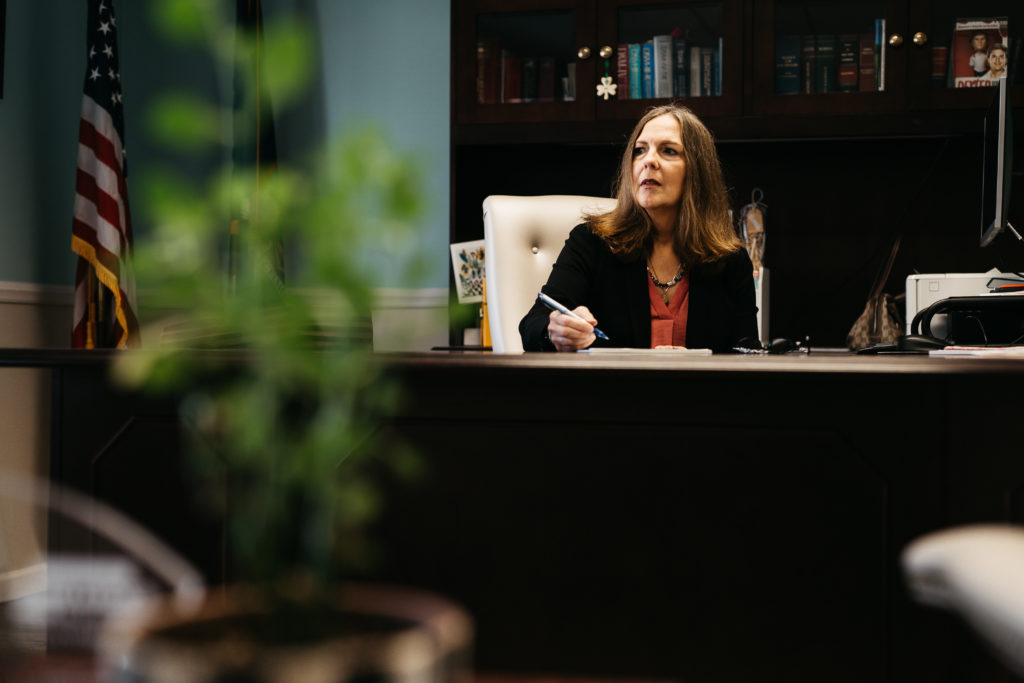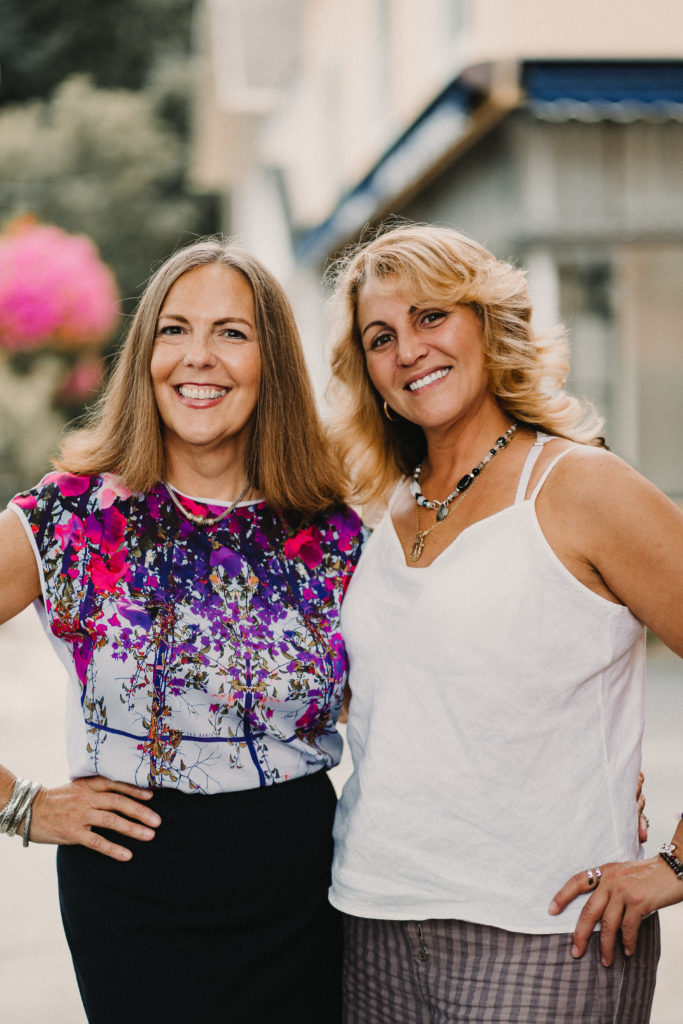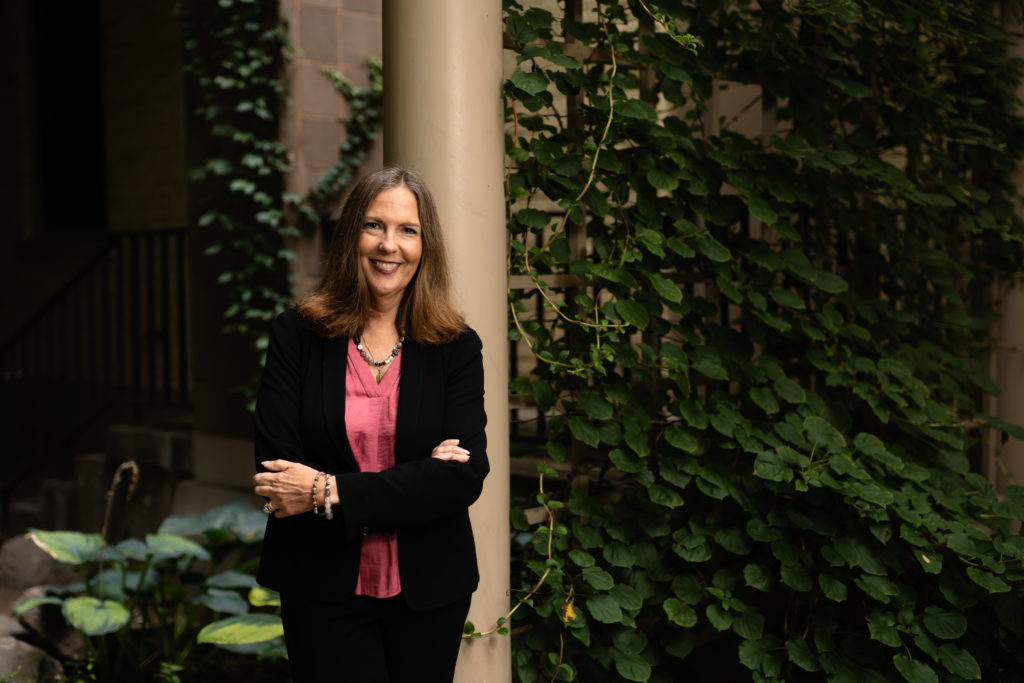PHOTOS BY CHARLENE MANN PHOTOGRAPHY
Elected in 2011, Sandra Doorley is the first female District Attorney in Monroe County history. In 2015, Doorley was re-elected to her second four year term. Prior to assuming office, Doorley served the District Attorney’s Office with distinction for nearly twenty years, successfully prosecuting thousands of high profile criminal cases and compiling an impressive record of victories.  After joining the office in 1992, Sandra Doorley served under two consecutive administrations in the following capacities:
After joining the office in 1992, Sandra Doorley served under two consecutive administrations in the following capacities:
• Chief of the Felony DWI Bureau (2004-2005)
• Deputy Chief of the Major Felony Bureau (2005-2008)
• Second Assistant District Attorney (2008)
• First Assistant District Attorney (2008-2011)
• Homicide Bureau Chief (2008-2011)
In January 2011, Sandra Doorley was honored by the New York State District Attorney’s Association with the Robert M. Morgenthau Award in recognition for her “professional accomplishments, honesty, integrity and commitment to the fair and ethical administration of justice. In July of 2015, at the District Attorney’s Association of the State of New York Summer Conference, The New York State Prosecutor’s Training Institute awarded Sandra Doorley the Prosecutor of the Year Award. At a later conference, Sandra Doorley was sworn in as President-Elect of DAASNY, placing her in line to be President in July of 2020.
Sandra Doorley is a graduate of the Syracuse University School of Law and performed her undergraduate studies at the University at Albany. She currently lives with her family in Webster.
Interview with Sandra Doorley: Behind the Scenes
In September, I had the opportunity to meet with Sandra Doorley, Monroe County’s District Attorney, about the ongoing heroin epidemic. She shared the efforts she has been making to mitigate its effects. As a mother of someone who struggles with addiction, taking the time to discuss her endeavors means a great deal to me. Addiction affects not only the individual, but the people around them, who could be family, friends, and co-workers, for example, and it is considered a disease due to how it affects the brain’s structure and processing, causing the individual to have a noticeable change in behavior. As a result, oftentimes, loved ones of someone struggling with addiction will say that it feels like they are interacting with a completely different person—and the truth is, they sometimes are.
One of the biggest concerns about addiction is the possibility of overdosing. In 2018, there were 1,133 reported overdoses in Monroe County, 166 of which were fatal. As of August, this year, there have been 559 reported overdoses, 82 of which were fatal. Unfortunately, not all overdoses are reported, and 94.4% of those who fatally overdosed were found to have fentanyl in their system, a substance that is sought out for “a really great high.” These statistics are tragic, knowing that they affect more than just the individual; along with non-reported overdoses, there are also those who struggle with addiction who don’t overdose, which remains unreported as well.
 One effort being enacted this year, Bail Reform, designed to both help those who cannot afford bail and to ameliorate the criminal justice system, had unintended consequences: for those struggling with addiction who committed a less severe, non-violent crime, who are then allowed to be exempt from bail are at risk when released. Since they have had time away in jail, their system has lost tolerance; after being discharged, it is likely they will overdose, not realizing how much their tolerance has decreased. Before Bail Reform, those struggling with addiction were rerouted through Opioid Stabilization Part, informally known as “opioid court.” Having a bail set prevented them from being able to leave while they waited for an open position in rehab, which can take a while. Though Bail Reform is a step toward addressing the inequity in the criminal justice system, now what do we do for those who need help who are falling through the cracks? Sandra is pushing for the Marchman Act, now a part of Florida’s laws, that determines in cases of emergency whether or not someone suffering from addiction is of sound mind to exercise self-control; if not, authority can temporarily be given to another to make decisions for them, for example, a parent choosing to send their child to rehab.
One effort being enacted this year, Bail Reform, designed to both help those who cannot afford bail and to ameliorate the criminal justice system, had unintended consequences: for those struggling with addiction who committed a less severe, non-violent crime, who are then allowed to be exempt from bail are at risk when released. Since they have had time away in jail, their system has lost tolerance; after being discharged, it is likely they will overdose, not realizing how much their tolerance has decreased. Before Bail Reform, those struggling with addiction were rerouted through Opioid Stabilization Part, informally known as “opioid court.” Having a bail set prevented them from being able to leave while they waited for an open position in rehab, which can take a while. Though Bail Reform is a step toward addressing the inequity in the criminal justice system, now what do we do for those who need help who are falling through the cracks? Sandra is pushing for the Marchman Act, now a part of Florida’s laws, that determines in cases of emergency whether or not someone suffering from addiction is of sound mind to exercise self-control; if not, authority can temporarily be given to another to make decisions for them, for example, a parent choosing to send their child to rehab.
Along with the Marchman Act, other efforts are being made to help Todd Baxter of the Monroe County Sheriff’s Department, who is working on having Monroe County Jail, to be one of the best inpatient treatment facilities. Deputy Mike Ricotta talks to individuals after their overdose. And in 2017, Doorley created the Heroin Task Force. Whenever an overdose occurs, fatal or not, law enforcement is now required to fill out information about it, 1) in order to keep track of the individual, 2) to find patterns and consistency between packaging, and 3) for cell phone numbers to track dealers. With this information, which is relayed to the Crime Analysis Center, the task force can then begin a long-term investigation.
The task force includes persons from the Rochester Police Department and two investigators who work full-time. Since its beginning, it has made great progress—the numbers are mostly consistent, but they aren’t getting worse, and have gone down a little. The Medical Examiner’s numbers have improved also, but there is still is some discrepancy depending on the case.
I extol Sandra for her efforts in criminal justice reform and the opioid epidemic; since her initial term as District Attorney in 2011, she has been instrumental in the Heroin Task Force, and is now working toward implementing the Marchman Act.
 My Personal Experience: The Void In Between
My Personal Experience: The Void In Between
In regard to criminal justice and the opioid epidemic, we as a county should always strive toward bettering the system and making efforts and communication more accessible. In 2014, my son Vincenzo Zagari hit his rock bottom after being shot by a Monroe County Sheriff while running away from the scene of his shoplifting. After his arduous stay in the hospital, we were faced with a new nightmare: navigating through the criminal justice system.
Since the shooting, we have made great strides in regard to recognition in the community with what is needed, but at that time, I felt as if the criminal justice system has failed us. The notoriety of his case stirred up an animosity and antagonism in people that bewildered me. I had been struggling for years, trying to just save my son from a deadly drug, yet was met with stalwart opposition wherever I turned. When he was shot, my son was no longer seen as a young man struggling for his own life; rather, he was treated as if he deserved his predicament, persecuted daily by media outlets and treated horrifically. As a mom, words cannot describe my furious indignation. Numerous statements came from other parents, asserting that he should have died that day, or that the officer involved in the shooting should have aimed better and shot him in the head. However, what people failed to realize was that my son actually did die on the ground that day.
At the scene, the EMTs refused to perform CPR on Enzo, who had been shot six times. A quote from the ambulance report: “… Even though he was in agonal distress, [an] EMT determined he did not need CPR at the time, [since] he was ‘just a heroin addict.’” Hearing this as a mom tore me apart—even in this critical moment, taking his last breath, he was deemed undeserving of CPR? Though many stated that they tried to save his life, private investigation and reports proved otherwise: people judged a young man simply because he made the wrong choice. This goes to show that the stigma towards addicts is still prevalent and can have deleterious ramifications in an emergency. Reading those reports took my breath away and made me sick to realize how deep the anger ran in the community for these kids struggling to stay alive with a dangerous drug. After he was taken to the hospital, my identity shifted from a parent of a drug addict to a parent in the throes of the judicial system; my son’s identity changed as well: in a sense, his addiction ended that night, and he became a ward of the state—in other words, a criminal.
 The damage from the bullets put my son in a coma, making him fight for his life as he was rushed into multiple surgeries over the course of twenty-two days just to stabilize him. As a mom of a sick or injured child, the only thing I could do was cry and pray that he would survive what he had just gone through. I was not thinking about him facing the courts and going to prison, I just wanted him to live.
The damage from the bullets put my son in a coma, making him fight for his life as he was rushed into multiple surgeries over the course of twenty-two days just to stabilize him. As a mom of a sick or injured child, the only thing I could do was cry and pray that he would survive what he had just gone through. I was not thinking about him facing the courts and going to prison, I just wanted him to live.
When he was deemed “well enough,” by the Monroe County Director of Nursing, he was relocated to jail without treatment while going through the hell that were his court proceedings. He wasn’t allowed bail in the beginning, and when we requested a hearing to set bail it was set at a million dollars per indictment leaving us paralyzed as to how to help him. Not receiving medical care or addiction treatment in jail and being unable to bring him home to recover, I agonized, wondering if he would even survive his proceedings. Additionally, the same drugs that he became reliant on from his addiction he now relied upon for his pain management.
At his first hearing, Enzo was unconscious when he was wheeled out, attached to an IV due to his pneumonia from collapsed lungs. His legs were swollen after losing a kidney and was barefoot. His initial appearance in such a weakened state made me gasp audibly; every sheriff present promptly put their hand on their gun, prepared and wary of my reaction.
The outside world was no better than the harrowing interior of the courtroom hearings—putting it nicely, I lacked support from the community. Not only was I slandered on the radio, but I also had co-workers I had known for years who turned up the volume on the radio to remind me. Daily routine existence was agonizing as well: while grocery shopping, other shoppers would slam their carts into mine. And traversing to and from the courtroom, I would be swarmed by the media, the assistant DA commenting on everything I was doing wrong as a mother, and once inside, the judge chastised me for an hour in front of the media.
I had been broken down and felt the courts actively opposed me personally. Enzo’s shooting was such a high profile case, that even though it brought such backlash from the community, it also opened a gate into seeing the culminating opioid epidemic through a different set of eyes: his case was around the time of the deaths of Matthew Stratton and Philip Seymour Hoffman, which began to awaken the public’s eye into realizing that indeed opioids were an epidemic. But before I realized the path that had unfolded before me, I hated the judicial system.
I hated it.
Bridget Davis, the officer who shot Enzo, laughed about the case and never attended any of the hearings. I felt so violated that my deep-seated resentment shifted to include Sandra Doorley. At the time, I didn’t understand that Sandra worked in an office, making decisions based on cases, not personal interactions, nor did I know the difference she wanted to make in the community. During her time in office, she developed cancer, putting her through her own journey of personal transformation.  When the elections came up, Patrick O’Flynn lost in the run for Sheriff. With Todd Baxter’s election, many of her efforts still went unnoticed, such as her advocacy for child abuse. Instead, Sandra was seen as someone who “wants to put people in jail.” Understanding how media can really skew the public’s perception of a personal experience, I decided to get to know Sandra as a person.
When the elections came up, Patrick O’Flynn lost in the run for Sheriff. With Todd Baxter’s election, many of her efforts still went unnoticed, such as her advocacy for child abuse. Instead, Sandra was seen as someone who “wants to put people in jail.” Understanding how media can really skew the public’s perception of a personal experience, I decided to get to know Sandra as a person.
Throughout all this, my father became gravely ill. Though heart-wrenching, his illness forced me to stop dead in my tracks. Being his caretaker, I had to let go of my obsession with saving my son, after which, Enzo realized that I wouldn’t and couldn’t do his time for him. He was presented with an urgent choice: get sober or die. As I stayed with my father until the moment of his death, once in prison, Enzo joined AA, headed by volunteers who really encouraged sobriety. This was a bittersweet time—though my father passed away, and Enzo was in prison, Life gave me the chance to view Enzo as my son again instead of a broken person I needed to save.
In my life, interpersonally and culturally, I’ve been a witness to the changing times. It was easy for others to throw out blame against the wrongfully accused, which I experienced on both sides, censuring the judicial system and Sandra, but also receiving judgment from the community. Walking through the fire taught me that the judicial system’s seeming hostility wasn’t personal. It also taught me that not everyone survives tragedy, especially one like addiction. My Enzo made a choice to live but was forced to make that choice. I am so proud of him, and I hope that I can give love and understanding to those who are struggling with addiction and the judicial system. The solution to
overcoming the opioid epidemic is not “cracking down on crime” and having addicts serve sentences in prison; rather, the key to combating the shame that comes with addiction is compassion, empathy, and knowledge—encouraging research and making it accessible for families and communities, teaching that addiction is indeed a disease since it changes the structure of the brain and genuinely affects the ability to rationally assess a situation and make a logical decision. I hope that no one else has to endure what we did, and that my story will help change the narrative for addiction treatment and outcomes.
“When ‘I’ is replaced with ‘we,’ ‘illness’ becomes ‘wellness.’” -Malcolm X
 Intersection
Intersection
It amazes me how the vast and varying roles people are in come together. Sandra was in a political position; I was in a personal one. And in spite of those differences, taking the time to learn about another’s perspective not only opened up my own world but also taught me newfound compassion and appreciation. Of course, I felt alone: the impersonal structure of the system was designed for justice, which can often exclude the very human aspects of life. But once I met Sandra and realized how much the opioid epidemic breaks her heart, my perception of her changed because the context of interaction changed—here we were, human to human, expectations and social roles set to the side for safekeeping. Human to human, we grieved the far-reaching effects of addiction, which has increased the incidence of domestic violence, and all the families, friends, and communities who have been affected by it; here we came together at an intersection, though from different walks of life, and shared both a mutual concern and future hopes for changing the current perceptions and treatments of addiction.






